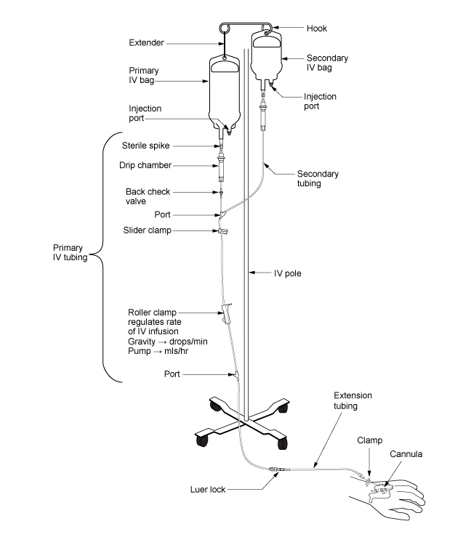Intravenous Infusions
In a hospital setting, many medications are given to patients through intravenous infusion. An infusion provides the patient continuously with a drug, 24 hours a day if needed. The drug is added to a large volume of parental fluid and is administered slowly over time. Chemotherapeutic agents, total parenteral nutrition and fluids such as aqueous solutions of dextrose, sodium chloride and lactated Ringer’s injection are administered through continuous infusion. Pharmacists should be able to calculate the rate of flow (infusion rate) of intravenous fluids. Infusion rates can be expressed as milliliters per minute, drops per minute, amount of drug per unit time, and often duration of time for total drug volume to be infused. Intravenous rates can be regulated in one of two ways:
Gravity: When using gravity for intravenous infusions, the infusion rate can be regulated by using a clamp on the IV tubing, which can speed up or slow down the flow of IV fluids. An IV flow rate for gravity is calculated in gtts/min (drops/min).
Electronic pump: When using electronic pump for intravenous infusions, the infusion rate is regulated by an electronic pump to deliver the fluids at the correct rate and volume. All IV pumps regulate the rate of fluids in ml/hr or ml/min.
An order for IV fluids may be continuous or a bolus, depending on the needs of the patient. IV solutions are available in 25 ml to 1000 ml bags. Some common solutions for intravenous infusions are listed in the next section.
The intravenous infusion bag is connected to a primary IV tubing (infusion set, administration set) which is thin, flexible plastic tubing which delivers the drug into patient’s vein (Figure A). Different types of primary IV tubing exist which deliver fluids at different rates. Drop factor of a primary IV tubing is defined as the number of drops delivered per ml. Primary IV tubing is either a macro-drip solution administration set that delivers 10, 15, or 20 gtts/ml, or a micro-drip set that delivers 60 drops/ml. Macro-drip sets are used for routine primary infusions. Micro-drip IV tubing is used mostly in pediatric or neonatal care, when small amounts of fluids are to be administered over a long period of time. The drop factor can be located on the packaging of the IV tubing (Figure B).

Figure A- Primary and Secondary Tubing Set up
Source: https://opentextbc.ca/clinicalskills/chapter/8-2-types-of-iv-therapy/

Figure B- Administration sets. A Set with drop factor of 10 (10 gtt/mL). B, Set with drop factor of 60 (60 gtt/1 mL).
Source: https://basicmedicalkey.com/intravenous-calculations/